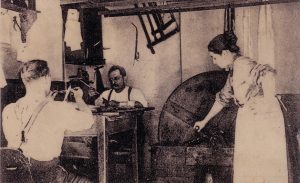Textile glass: Angel hair machine - German/German

Since the middle of the 19th century, wafer-thin glass threads were drawn from glass rods in Lauscha in the Thuringian Forest. The spinning apparatus used for this was called an "angel hair machine". Smooth glass threads were used for bird tails, rosettes and angel wings, curly glass threads as "angel hair" for tinsel angels and for decorating Christmas trees.
In contrast to the smooth angel hair, two different types of glass are needed for the curly angel hair: the hard Duran glass and the softer AR glass. Only when these two types of glass with different softening temperatures and different expansions melt together in the flame does the tension necessary for the "curls" arise in the glass.
Based on this "patent", Werner Schuller developed the rod drum drawing process for the first spinnable glass fibre in his company Schuller Textilglas in Thuringia in 1936. Although optimised for industrial purposes at Johns Manville in the meantime, the drawing out of glass threads still forms the basic principle for the production of glass fibres today.
Textile Glass: Angel's Hair Machine - English

From the mid 19th century onwards, gossamer glass threads were drawn from glass rods in Lauscha in the Thuringian Forest. The spinning machine used to produce them was called an "Angel's Hair Machine". Smooth glass threads were used for bird's tails, rosettes and angel's wings, while curly glass threads were used as angel's hair for traditional gold-coloured Christmas tree fairies and other Christmas tree decorations.
In contrast to straight angel's hair, curly angel's hair requires two different sorts of glass: hard Pyrex glass and soft AR glass. These two have different softening points and stretch differently when heated, so when they're melted together the tension required to generate the curls is created.
The Werner Schuller company in Thuringia patented the technique and in 1936 Werner Schuller went on to develop the first glass-fibre drawing machine process for the first threads that could be "spun"... And even though the Johns Manville company has optimized the process for industrial production, the basic principle of drawing the threads is still used today.